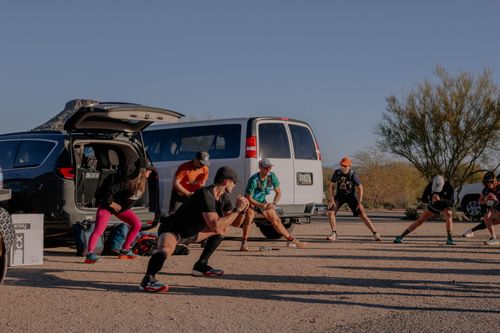Trail and ultrarunning demands more than just endurance—you need strength, stability, and resilience to handle steep climbs, technical descents, and long miles. Incorporating strength exercises into your training can improve performance and reduce injury risk.
Here are three essential movements to add to your routine, along with ways to progress as you get stronger:
1. Single-Leg Step-Up
Why it’s important: Trail running requires strong, stable legs for uphill climbing and maintaining control on uneven terrain. The single-leg step-up enhances leg strength, balance, and coordination—key components for powering up hills and maintaining efficiency over long distances.
How to do it:
- Find a sturdy bench or step about knee height.
- Place one foot on the step and push through your full foot to lift yourself up.
- Control the movement as you step down.
- Perform 3 sets of 10-12 reps per leg.
How to progress:
- Add weight by holding dumbbells or wearing a weighted vest.
- Slow down the movement to emphasize control and eccentric strength.
- Increase step height to challenge range of motion.
2. Depth Landing
Why it’s important: Technical descents require strong eccentric control to absorb impact and prevent injury. Depth landings improve reactive strength, absorption ability, and prepare your muscles for the repeated pounding of downhill running.
How to do it:
- Stand on a box or step about 12–18 inches high.
- Step off and land softly in an athletic position with knees slightly bent.
- Absorb the impact and hold for a second before standing tall.
- Perform 3 sets of 8-10 reps.
How to progress:
- Increase the height of the step up to 40 inches high to challenge impact absorption.
- Add a jump immediately after landing to develop explosive strength.
- Perform depth landings on one leg to improve single-leg stability.
3. Pogos
Why it’s important: Trail running involves frequent small jumps over rocks, roots, and uneven ground. Pogos develop ankle stiffness and reactive strength, improving foot speed and reducing energy loss on varied terrain while improving running economy.
How to do it:
- Stand with feet hip-width apart.
- Keep your knees mostly straight and use your ankles to bounce up and down, like a jump rope motion.
- Perform quick, light jumps for 20-30 seconds.
- Repeat for 3 sets.
How to progress:
- Increase jump height for more power.
- Perform single-leg pogos to challenge ankle stability.
- Incorporate these exercises into your routine 2-3 times per week, and you’ll build the strength and resilience needed to tackle tough trails and long distances with confidence.

